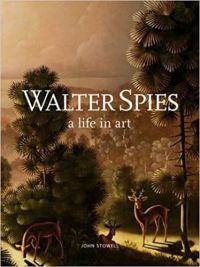Walter Spies: A Life in Art
- Title
- Walter Spies: A Life in Art
- Original language
- English
- Author(s)
- Illustrator(s)
- Publisher
- Afterhours Books
- ISBN
- 6029658808
- Publication date
- May 15, 2012
- Subjects
- Find Book
- Tokopedia
- Related Env. Initiatives
- Related Places
- Related Biographies
- Related Children's Books
- Related Holidays
- Related Folktales
- Related Comics
- Related Lontar
- Linked words
Description(s)
With the publication of Walter Spies: A Life in Art we have at last an exciting and superbly illustrated biography of not only the man but of a whole age. In the years leading up to his premature death in 1942, this iconic multifaceted artist made a significant and long-lasting impact on the early development of Balinese painting in the modern era. Spies took a leading role in the establishment of the Pita Maha association of artists, an attempt to improve the overall quality of painting in the flourishing art market in which participating artists’ work would be submitted for approval to an art guild. Right from its opening pages, the book is full of stunning full page and two-page reproductions of paintings, presented more or less in chronological order, that illustrate the artist’s singular surreal style – toy villages, unusually steep roofs, accentuated torsos, rhythmic treatment of landscapes, multiple horizons – that has been described as “puzzling,” “subversive,” “magic” and “closer to expressionism than in realism.” In the end, of course, each viewer sees in his paintings what they want to see. Spies’s remarkable life wasn’t even brought to light to a wider public until 1964 when the Hague mounted a retrospective exhibition of the painter’s work. Besides a book of Spies’ photographs (The Imaginary Museum, 1996), only one other non-fiction book (Walter Spies and Balinese Art by H. Rhodius) has ever been published about the artist, and that was over 30 years ago. A blend of classy art book, scholarly history and down to earth biography, this dense and handsome chronicle of Spics’s life is told against the backdrop of the traditional arts and culture of the Balinese and the workings of Dutch colonial society in the complex and colorful world of the Netherlands Indies in the 1930s before it was all swept away by the cataclysm of the Second World War. In the course of the book we meet comedian Charlie Chaplin, playwright Noel Coward, novelist Vicki Baum, Woolworth heiress Barbara Hutton, painters Willem Hofker and La Mayeur. Spies corroborated on a book with musicologist Beryl de Zoote, assisted Colin McPhee of A House of Bali fame, befriended Margaret Mead and Gregory Bateson, the foremost anthropologists of the time, and served as consultant for writer Miquel Covarrubias who wrote and illustrated Island of Bali which remains to this day one of the most thorough and definitive ethnographies of Bali ever written.
When he died 70 years ago, the artist Walter Spies was known to only a few close friends. Now he is prized as one of the finest painters of the tropical landscape. In the turmoil of war and the turbulence of the post-war years, his fate remained for a time unknown and his life and deeds in Bali gradually took on mythic proportions. He was remembered almost as a founding figure, one who had taken the arts of Bali to unprecedented heights. What remains of Walter Spies, the lasting documents of his achievement, are a mere handful of works, if we compare them with the prodigious output of many painters. He completed no more than 80 major paintings, of which only about 40 are known to still exist.Spies's works have always been prized by their owners and in the main they have remained in private hands. This means they were for a long time not generally well known and it has proved hard to bring them together for exhibition. However, larger exhibitions were held in the Netherlands in 1964 and again in 1980, with many works in the latter exhibition also shown in Germany.This book presents a fully documented biography in an 80,000-word text. It places the works and related documents in chronological order and supplies a catalogue of all the known works, including mention of those that have been lost, and an analytical index. The biography, traces the remarkable life of an exceptional individual whose career touched at many points the challenging issues of the first half of the twentieth century. In detention he kept up his music and painting as best he could, but lost his life when a ship taking civil internees to safety was sunk by a bomb from a 'friendly' reconnaissance plane.







Enable comment auto-refresher